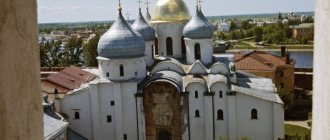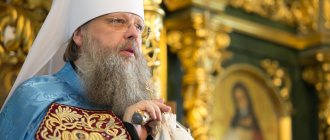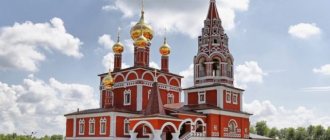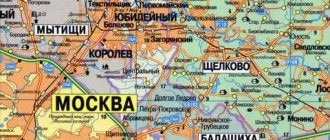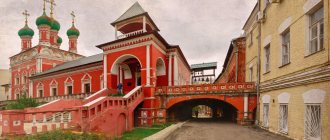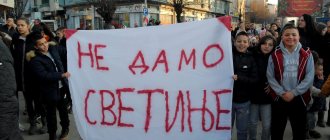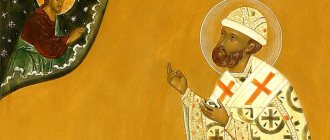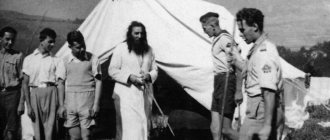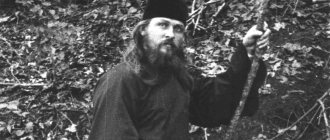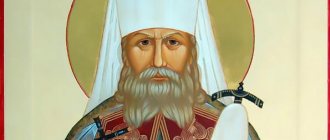Navigator: Metropolitan Pavel of Minsk and Zaslavsky / Biography
Metropolitan Pavel of Minsk and Zaslavsky, Patriarchal Exarch of All Belarus
Date of Birth: February 19, 1952 Date of Ordination: March 22, 1992 Angel Day: July 12
In the world - Georgy Vasilyevich Ponomarev. Born on February 19, 1952 in Karaganda, in a family of workers. Studied in high school. Served in the Soviet Army. After demobilization he worked as a driver and mechanic. Studied at a vocational school.
In 1973-1976. studied at the Moscow Theological Seminary. In 1980 he graduated from the Moscow Theological Academy with a candidate's degree in theology. In 1980-1981 — postgraduate student at MDA.
In October 1977 he was accepted into the brethren of the Trinity-Sergius Lavra, and in December he was tonsured into the mantle by the abbot of the Lavra, Archimandrite Jerome (Zinoviev; †1982).
In March 1978 he was ordained a hierodeacon, and in May a hieromonk.
In 1979-1981 - Referent of the Department of External Church Relations.
Since September 1981 - member of the Russian Spiritual Mission in Jerusalem. Since July 1982 - Deputy Head of the Mission. In 1983, Patriarch Diodorus I of Jerusalem elevated him to the rank of abbot. From July 1986 to July 1988 - head of the Russian Spiritual Mission in Jerusalem. In August 1986, Patriarch Diodorus I of Jerusalem elevated him to the rank of archimandrite.
In 1988-1992 - Abbot of the Pskov-Pechersky Monastery.
By the decision of the Holy Synod of February 19, 1992, he was determined to be the Bishop of Zaraisk, administering the Patriarchal parishes in the USA and temporarily in Canada. On March 21, 1992, the naming ceremony in the Epiphany Cathedral was performed by His Holiness Patriarch Alexy II, Metropolitans of Krutitsky and Kolomna Yuvenaly, Rostov and Novocherkassk Vladimir, Pskov and Velikoluksky Vladimir, Archbishop Sergius of Solnechnogorsk, Bishops of Istra Arseny and Podolsky Viktor. On March 22, 1992, during the Divine Liturgy in the Epiphany Cathedral, His Holiness Patriarch Alexy II and the Bishops who participated in the naming consecrated him Bishop of Zaraisk, vicar of the Moscow diocese.
In 1999 he was appointed Bishop of Vienna and Austria.
In 2001 he was elevated to the rank of Archbishop with the title of Vienna and Budapest.
Since May 7, 2003 - Archbishop of Ryazan and Kasimov.
By the decision of the Holy Synod of October 5-6, 2011 (magazine No. 104), he was awarded the title of Ryazan and Mikhailovsky, appointed (magazine No. 132) as the head of the newly formed Ryazan Metropolis.
On October 8, 2011 he was elevated to the rank of metropolitan.
By the decision of the Holy Synod of December 25, 2013 (journal No. 126), he was appointed His Eminence of Minsk and Slutsk, Patriarchal Exarch of All Belarus.
By the decision of the Holy Synod of October 23, 2014 (magazine No. 93), he was awarded the title of Minsk and Zaslavsky and appointed head of the newly formed Minsk Metropolis.
Awarded the orders of St. Innocent of Moscow, St. Sergius of Radonezh, Blessed Prince Daniel of Moscow and St. Seraphim of Sarov (all II degrees).
December 4, 2021, on the feast of the Entry into the Temple of the Blessed Virgin Mary, the day of the 100th anniversary of the enthronement of St. Tikhon, Patriarch of Moscow and All Rus', in the Cathedral Cathedral of Christ the Savior in the city of Moscow during a solemn service in accordance with clause 2.2.4 of the Regulations on Awards The Russian Orthodox Church was awarded the right to wear the second panagia within the canonical boundaries of the Belarusian Orthodox Church.
He has awards from the Antiochian, Jerusalem and American Orthodox Churches.
Awards:
Church:
- 2012 - Order of St. Innocent of Moscow II century;
- 2017 - Order of St. Seraphim of Sarov, 1st class;
- 2019 - Order of St. Anthony and Theodosius of Kiev-Pechersk (UOC);
- Order of St. Sergius of Radonezh II century;
- Order of St. blgv. book Daniel of Moscow II century;
- Order of St. Seraphim of Sarov, II century;
- Orders of the Jerusalem, Antioch and American Orthodox Churches.
Secular:
- 2015 - the highest award of the movement “For Saving the People” (Russia);
- 2017 - memorial sign “In honor of the founding of the National Academy of Sciences of Belarus”;
- 2017 - medal “Honored Peacemaker”.
events
- Third session of the “Dialogue of Civilizations” forum (October 5, 2005)
- Concelebration of Pope Benedict XVI and Patriarch Bartholomew I. Vatican, June 29, 2008 (June 29, 2008)
- Local Council 2009 (January 27, 2009)
- XIII World Russian People's Council (May 21, 2009)
- XV World Russian People's Council (May 25, 2011)
- Prayer for Peace (2013 Forum) (September 29, 2013)
- V Congress of Leaders of World and Traditional Religions (June 10, 2015)
- XIX World Russian People's Council (November 10, 2015)
- Metropolitan Nikodim: the path of serving the Church (conference) (October 15, 2019)
- VI Plenum of the Christian Interfaith Advisory Committee (October 30, 2019)
- II Baku Summit of World Religious Leaders (November 14, 2019)
Siberian hardening
– So you ended up in Siberia?
– Immediately upon returning to Trekhgorny, I began to find out about the trip. I took two weeks off in February 1998 and went to Novosibirsk. And here there is a snowstorm, the famous February snowstorms, snowdrifts higher than the rooftops - these were my first impressions of Siberia.
I was sent to the village of Kozikha. I remember the brothers were building something, wearing something, not talking much, and were increasingly silent. I was introduced to Hieromonk Artemy (Snigur, now Archbishop of Petropavlovsk and Kamchatka), noting that he was the eldest here. We talked with Vladyka for an hour and a half. In this conversation, in fact, he gave me a program for the rest of my life, saying: “We are building churches in Siberia, but we still need to build a temple in our hearts.”
In Kozicha I first lived as a pilgrim. The first obediences were difficult. One day my brother and I were given the task of bringing water to the bathhouse. And the pump is one kilometer away from the monastery. They gave us two flasks for each sled. The senior comrade said that we would rest until six in the evening, but I did not listen and decided to carry bricks all day.
Evening came. It's time to go get water, but I don't have the strength. It's dark outside, there's a snowstorm, the roads are swept, the sleds won't move. My partner began to help me: first they carried his sled, then mine, and part of the way they carried the flasks on themselves, and so on several times. I returned to my cell covered in snow, completely exhausted. At that moment I made a discovery for myself that one must show obedience in everything.
Vladyka Artemy began to humble me. One day I was given tarpaulin boots for work, and before putting the boots into the warehouse, I decided to wash and polish them. Father Artemy was going to Novosibirsk at that time and told me the exact time when I should stand by the car. While I was cleaning my boots, I was a few minutes late, and all the way to Novosibirsk I listened to a reprimand about why I was late. And already in the city, the bishop asked me: “Well, will you come back?” I promised.
A couple of years later, I found an entry in the monastery diary: “The pilgrim Alexander came from Chelyabinsk, performed such and such obediences, left, promised to return. Let's see…"
– How long did you stay in the monastery as a pilgrim?
- Two weeks. And, despite the fact that the conditions were difficult, spartan (the cell had adobe walls, half the space was occupied by a stove, where we slept), I really liked it in Kozikha. I realized that this was what I had read about in patristic literature: the modern brethren lived and labored in remote Siberia, just as it was written about in the monastic lives.
After the morning rule, Liturgy and breakfast, all the brethren went to work - until 20.30. There was not enough sleep, there were no days off. Only twice a week was it possible to rest a little: on Thursday evening (bath day) and on Sunday after the service.
– At that time there was still a convent in Kozicha?
– Yes, the brothers helped with the construction there. The men's monastery was located in the village of Maloirmenka, 20 kilometers from Kozikha, where the convent is now located. In Kozikha there is more space, large equipment could enter the territory, but in Maloirmenka everything is very compact. Therefore, as soon as the construction work was more or less completed, in the summer of 1998 the monasteries were swapped.
– Vladyka Pavel, how did your parents react to your choice of life path?
– I once read that you need to take a blessing from your parents to become a monk, and I went to Kazakhstan to get it. There are several brothers in our family, but only I had a higher education, so I was considered hope for my parents, they thought that I would eventually “raise” the whole family, that we would be able to get out of poverty, but here is such news - monasticism.
Mom agreed almost immediately, but dad was perplexed: “I don’t understand you. You will work for someone. But you’re an adult, decide for yourself.” It was only later that my parents arrived at the monastery, and my dad saw that the governor worked harder than us, that the brethren were all hard workers. Dad himself worked with us (he is a builder by profession), calmed down and went to confession for the first time. This was a great consolation for me. What happened is what they say when a person goes to a monastery: the whole family begs, and the Lord helps the monk’s relatives. So my relatives began to slowly become church members.
– It turns out that your tonsure took place in Kozikha?
– I arrived at the monastery on March 19, 1998, and in July I was tonsured into the mantle by the abbot of the monastery, Hieromonk Artemy (Snigur) with the name Pavel, in honor of the Apostle Paul.
sources
- Pavel, Metropolitan of Minsk and Zaslavsky, Patriarchal Exarch of All Belarus (Ponomarev Georgy Vasilyevich) // patriarchia.ru
- Metropolitan of Ryazan and Mikhailovsky Pavel. Curriculum Vitae
Footnotes
- https://www.patriarchia.ru/db/text/4951267.html
- History of the Diocese Archived November 2, 2013 on the Wayback Machine. Hungarian diocese.
- Journals of the meeting of the Holy Synod from October 5-6, 2011, Journal No. 104. Patriarchy.ru
- His Holiness Patriarch Kirill elevated a number of bishops of the Russian Orthodox Church to the rank of metropolitan. Patriarchy.ru.
- Journals of the meeting of the Holy Synod of December 25, 2013. Official website of the Moscow Patriarchate.
- Journals of the meeting of the Holy Synod of August 25, 2021 // Patriarchy.ru. – 2021. – August 25. – Date of access: 31.8.2020.
- Metropolitan Pavel of Minsk: Speaking about the era of Metropolitan Joseph (Semashko), we call on everyone to maintain peace on Belarusian soil // Patriarchy.ru. – 2021. – March 21. – Date of access: 03/28/2018.
Construction of the soul
– You saw a period of active construction at the monastery. How do you remember him?
– Basically, all my first obediences were related to construction: there was a lot of construction going on in Kozikha at that time. Something was moved from one place to another, bridges were built from sleepers - at night, under flashlights and searchlights. The fact is that often the work did not stop until the morning; this was called “turning on the light bulb.” Whoever didn’t know and asked what it was, they answered: “You’ll find out in the evening” ( smiles
).
In winter it reached minus 27 degrees, however, the brothers continued to work in the cold: brick, masonry, concrete, mortar. Wearing mittens and sweatshirts, but they coped with the assigned tasks. That’s how Father Naum’s wooden house was built – within 24 hours, when they were expecting him to visit: they started at 9.00 and finished by the next morning.
Vladyka Artemy once served in the army, so he taught us to do everything in a military way - quickly, quickly. Of course, many could not stand the difficult conditions and left, not realizing that this was how it should be. I compared our problems with what I read in books and realized that monks have gone through similar trials at all times.
Later I was appointed cellarer, and during this obedience I was also helped by reading about monasticism, which I was interested in as a student. However, I was at a loss as to what and how to make: pickles, preparations, and so on. I knew that when they give difficult obediences, you cannot refuse, you need to take on any work. Not understanding where to start, I saw an empty flask in the kitchen (and there should be water in it) and went to get water. Vladyka Artemy drove by in a Niva, stopped and asked: “So, did you decide to start with a flask? This is right".
Then I began to build storage facilities for vegetables, warehouses for raw materials, asked advice from knowledgeable people and gradually mastered the obedience of a cellarer.
– The construction of temples and monastery buildings was at that time the main task in the monastery. You have a lot of experience in this. Share your thoughts and conclusions obtained over many years of practice - how can a monk combine work and prayer?
“For many years, in difficult conditions, we were engaged in construction, not only on the territory of the monastery, but also in nearby villages - we built churches so that every resident had the opportunity to come to God. However, construction did not prevent us from serving the Lord; we prayed, as they say, “on the job.”
The brethren confessed regularly; during construction, the confessor walked around the territory of the monastery with an epitrachelion. This is how we lived for many years. We prayed during the work process and attended Liturgy every day. And when the period of large-scale construction ended, it was decided that all the brethren would attend all monastic services.
– Vladyka, have you always been obedient in the monastery?
– For almost four years, with the blessing of the monastery’s holy archimandrite, Bishop Tikhon, I served as a full-time priest at the bishop’s metochion in honor of the icon of the Most Holy Theotokos “Quick to Hear” (St. Mochishche, Novosibirsk region). Then I was returned to Kozikha as a dean, and again I had to delve into economic issues.
